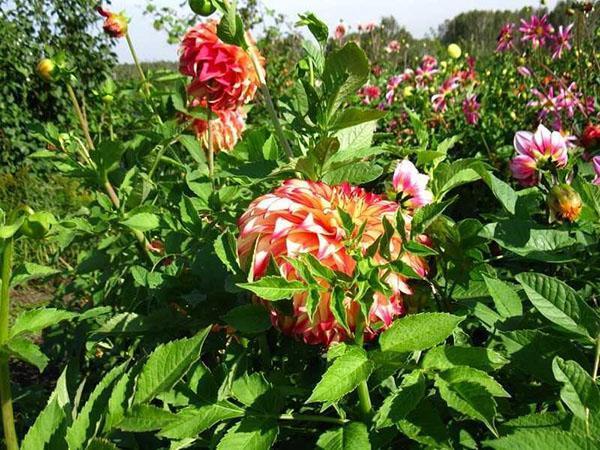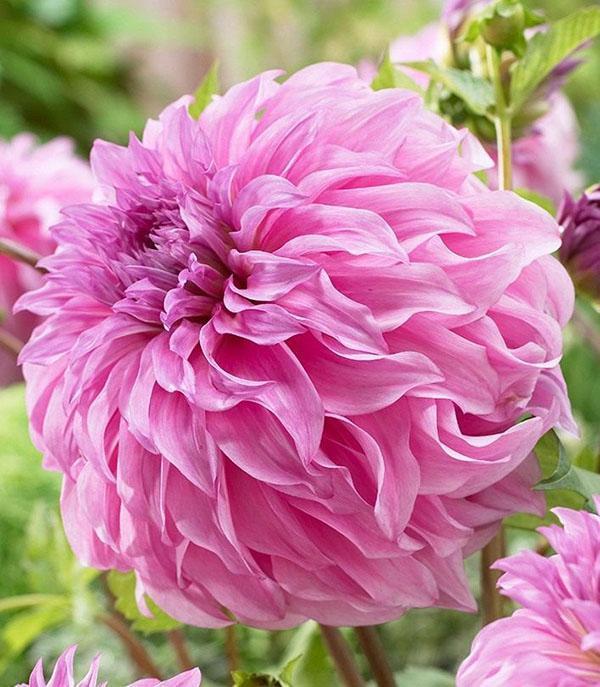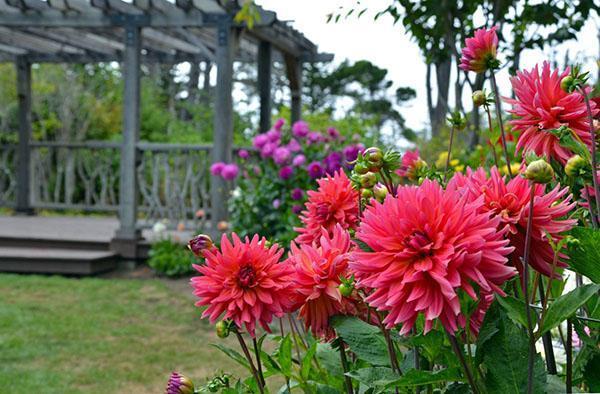Lush blooming of dahlias in the open field depends on planting tubers and plant care
 Guatemala and Mexico are considered to be the homeland of these beautiful flowers. Dahlias appeared in the Old World in the 18th century, where they began to successfully plant and care in the open field. The flowers were immediately given two names - dahlia and dahlia. The first name was given to the plant in honor of the famous botanist from Sweden - A. Dahl, and the second - to the scientist from St. Petersburg - I. G. Georgi.
Guatemala and Mexico are considered to be the homeland of these beautiful flowers. Dahlias appeared in the Old World in the 18th century, where they began to successfully plant and care in the open field. The flowers were immediately given two names - dahlia and dahlia. The first name was given to the plant in honor of the famous botanist from Sweden - A. Dahl, and the second - to the scientist from St. Petersburg - I. G. Georgi.
Flower varieties

Botanists divide the flower into the following groups:
- Simple.
- Anemonoid.
- Collar.
- Peony.
- Decorative.
- Spherical.
- Pompom.
- Cactus (needle-like).
- Semi-cactus.
- Nymphaean.
- Mixed - other varieties that are not included in the previous groups.
 Colorful, gorgeous dahlias of different colors (white, burgundy, scarlet, pink, cream and many others) are the decoration of our summer gardens.
Colorful, gorgeous dahlias of different colors (white, burgundy, scarlet, pink, cream and many others) are the decoration of our summer gardens.
The dream of breeders is the blue dahlia. However, the efforts of botanists have so far not been crowned with success.
However, these delicate flowers cannot stand the harsh Russian winters, so those who want to enjoy the beauty of their bright buds all summer long should plant the tubers annually. So, in the Moscow region, you can plant dahlias in open ground in mid-May. But in its homeland - in Latin America - this amazingly beautiful flower is a perennial.
Planting dahlias in open ground
The most convenient and effective method of growing dahlias is planting and care in the open field.
Land preparation
The soil for flowers is harvested in advance. Prepare the soil for planting dahlia before the onset of winter frosts. In the fall, the earth is dug up and fertilizer is applied to it - either compost or humus, which are added to the soil at the rate of 4 kg per 1 m2.
In the spring, the soil is enriched again, with a mixture of compost and ash, which are scattered over the entire area of the flower bed. Then the earth must be loosened with a rake. Fertilizer can also be added to prepared planting holes.
Dahlias are planted in the spring in the soil with a loose structure. Gravel, river sand, crushed coal slag will help to increase its permeability and fertility. This drainage will keep the crop free of excess moisture, which can cause harmful mold and rot.
Dahlia quickly deplete the soil, so they should not be planted in the same place for two years in a row.
It is desirable that the reaction of the soil is slightly acidic or neutral. Slaked lime is added to the peroxidized soil, and a little peat is added to the alkaline one.
Tuber preparation
Dahlia tubers intended for planting in the open field need special care. With the onset of April, move the root tubers from the cellar to the greenhouse, remove the rotten areas. Put in boxes, cover half with fresh turf soil, peat, sand, sawdust. The root collar is left open. Water the substrate periodically. Eyes will appear in about ten days. Remove root tubers from the soil, shake off, put on a hard surface.
 A thin knife blade must be sterilized with a manganese solution or ignited in a fire.Divide the stem into four parts (quarters) with a vertical cut. Each division must have several root tubers and at least one regeneration bud, otherwise it will not be able to germinate. The cut is sprinkled with crushed activated carbon. Keep tubers in a greenhouse until they take root.
A thin knife blade must be sterilized with a manganese solution or ignited in a fire.Divide the stem into four parts (quarters) with a vertical cut. Each division must have several root tubers and at least one regeneration bud, otherwise it will not be able to germinate. The cut is sprinkled with crushed activated carbon. Keep tubers in a greenhouse until they take root.
Approximately 30 days before disembarkation, planting material is taken out of storage. The tubers are cleaned of damaged tissue by sprinkling the cut with activated carbon. You can treat the culture with foundation, or hold it for 17 - 18 minutes in a weak solution of manganese. Next, the processed tubers are placed in low containers with a mixture of earth and river sand.
Initially, the containers are kept in a warm, shaded area with moderate watering. When the sprouts reach a height of more than 2 cm, they are transferred to a lighted place. It is rarely necessary to water the sprouts, it is desirable only to moisten the ground. They are planted in the first decade of May. No need to cover.
When is it better to plant dahlias outdoors in spring? The planting time is related to the climate of the region. For central Russia, this is the third decade of May. For the southern regions - April. For the northern ones - the beginning of summer.
Dahlias should be planted in open ground in Siberia and taken care of in the second decade of June.
Site preparation
 This culture loves warmth, so it is important to choose the right place. A flower bed should be located in a sunny area that is not blown through by drafts.
This culture loves warmth, so it is important to choose the right place. A flower bed should be located in a sunny area that is not blown through by drafts.
Some varieties have a fairly tall stem that breaks off easily from a strong gust of wind. Such varieties need support - stakes made of wood, 1.5–2 meters high. It is advisable to install them in advance.
Ideal location: near the wall, on the south side of the building. It is recommended to plant flowers next to a group of shrubs and trees in a sufficiently lighted area. However, trees near flowers should not give a thick shade, as dahlias are very fond of light. Closeness and impenetrable thickets are not suitable for these freedom-loving flowers.
First, the site is leveled, after which the holes are prepared. Tubers are planted in open ground, then they are covered with a layer of earth a few centimeters. Provide enough sun and light for the tubers. watering.
 There is another method of propagation of this culture - cuttings. But this is a very laborious and responsible occupation. And if you are worried about these troubles, then you can grow an annual plant from seeds, these are:
There is another method of propagation of this culture - cuttings. But this is a very laborious and responsible occupation. And if you are worried about these troubles, then you can grow an annual plant from seeds, these are:
- ColtnessHybrids;
- Redskin;
- Rigoletto;
- Figaro.
Seeds are sown in open ground in mid-May and bloom by mid-August. To get early flowering, the seeds will have to germinate.
Collection and storage of root tubers
 Dahlias planted in open ground in the fall also need care. Before frost, the bush should be spud and the leaves on the lower part of the stem removed. It is recommended not to rush to dig up the tubers! When the ground part dies, it is cut off, and the tubers are left in the ground. Within two weeks, their rind will harden and starch will form. And only after the first frost (before the onset of large frosts), the root tubers should be dug up and washed. This is done in the morning so that they air dry during the day.
Dahlias planted in open ground in the fall also need care. Before frost, the bush should be spud and the leaves on the lower part of the stem removed. It is recommended not to rush to dig up the tubers! When the ground part dies, it is cut off, and the tubers are left in the ground. Within two weeks, their rind will harden and starch will form. And only after the first frost (before the onset of large frosts), the root tubers should be dug up and washed. This is done in the morning so that they air dry during the day.
 Planting material is stored in a cellar, in a box with a mixture, which includes earth, vermiculite, sand, sawdust, peat. The optimum room humidity is 60–70%.
Planting material is stored in a cellar, in a box with a mixture, which includes earth, vermiculite, sand, sawdust, peat. The optimum room humidity is 60–70%.
Ventilate the storage periodically.
In January, it is necessary to re-examine the tubers in order to divide large ones. If affected areas are found, it is necessary to remove them, and treat the cut sites with brilliant green solution (you can lubricate with crushed activated carbon).
Dangerous pests
The most important enemies of the plant are:
- aphid;
- slug;
- color beetle;
- caterpillar;
- earwig;
- etc.
To fight slugs, the earth is sprinkled with metaldehyde. From aphids - the shoots are dipped in a soapy solution or sprayed with a 0.2% chloroethanol solution.Hot weather favors the development of spider mites, which infect the lower part of the leaves. They turn yellow, dry and die. The diseased culture is irrigated with celtan (0.2%). A decoction of celandine and wormwood is also used against pests.
It is recommended to plant marigolds near dahlias - many pests cannot stand their smell.
 So, magnificent dahlias are distinguished by a variety of shapes and colors, lush long flowering. If you follow the above recommendations, you can easily grow these gorgeous flowers in your backyard.
So, magnificent dahlias are distinguished by a variety of shapes and colors, lush long flowering. If you follow the above recommendations, you can easily grow these gorgeous flowers in your backyard.